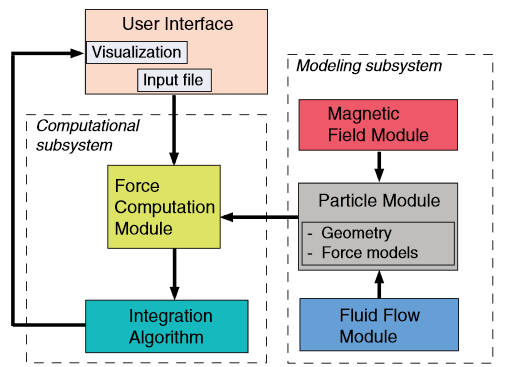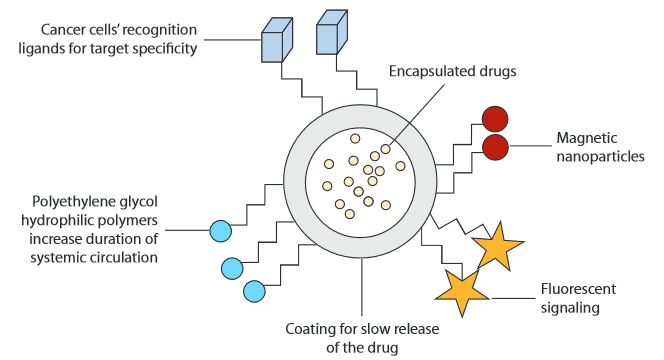Steering toxic drug-filled nanoparticles to zap cancer, not healthy cells
November 26, 2013

Artist’s impression of drug-filled magnetic nanoparticle (credit: Northeastern Magnasim team)
[+]
The drugs used to kill cancer cells are just as toxic to neighboring
healthy cells, so researchers have long sought a drug delivery method
that targets only cancer cells, bypassing the healthy ones.
Magnasim software architecture (credit: P. Vartholomeos et al./IEEE Transactions on Biomedical Engineering)
Functional Magnetic Resonance Imaging (fMRI) is being used clinically to guide drug-filled magnetic nanoparticles, but controlling their course accurately is still more an art than a science, said Dinos Mavroidis, Distinguished Professor of Mechanical and Industrial Engineering at Northeastern.
“There are only a few groups worldwide that are working on targeted drug delivery using magnetic fields,” Mavroidis explained to KurzweilAI. “We are collaborating with most of them. So far there is no commercial product on the market for targeted drug delivery using magnetic fields or for the simulation software. We expect the Magnasim software to be on the market in 1–2 years.”
Full disclosure: I was formerly a member of a research team at Biophan Technologies, Inc. developing technologies to guide drug-filled magnetic nanoparticles, but I have no current financial interests aside from a small amount of stock. — Amara D. Angelica, Editor
Abstract of IEEE Transactions on Biomedical Engineering paper
A computational platform has been developed to perform simulation, visualization, and postprocessing analysis of the aggregation process of magnetic particles within a fluid environment such as small arteries and arterioles or fluid-filled cavities of the human body. The mathematical models needed to describe the physics of the system are presented in detail and also computational algorithms needed for efficient computation of these models are described. A number of simulation results demonstrate the simulation capabilities of the platform and preliminary experimental results validate simulation predictions. The platform can be used to design optimal strategies for magnetic steering and magnetic targeting of drug-loaded magnetic microparticles.
Abstract of Annual Reviews Biomedical Engineering paper
[+]
This review presents the state of the art of magnetic resonance
imaging (MRI)-guided nanorobotic systems that can perform diagnostic,
curative, and reconstructive treatments in the human body at the
cellular and subcellular levels in a controllable manner.
Multifunctionalized drug-loaded nanoparticle (credit: P. Vartholomeos et al./Annual Reviews Biomedical Engineering)
The concept of an MRI-guided nanorobotic system is based on the use of an MRI scanner to induce the required external driving forces to propel magnetic nanocapsules to a specific target.
It is an active targeting mechanism that provides simultaneous propulsion and imaging capabilities, which allow the implementation of real-time feedback control of the targeting process. The architecture of the system comprises four main modules: (a) the nanocapsules, (b) the MRI propulsion module, (c) the MRI tracking module (for image processing), and (d) the controller module.
A key concept is the nanocapsule technology, which is based on carriers such as liposomes, polymer micelles, gold nanoparticles, quantum dots, metallic nanoshells, and carbon nanotubes. Descriptions of the significant challenges faced by the MRI-guided nanorobotic system are presented, and promising solutions proposed by the involved research community are discussed. Emphasis is placed on reviewing the limitations imposed by the scaling effects that dominate within the blood vessels and also on reviewing the control algorithms and computational tools that have been developed for real-time propulsion and tracking of the nanocapsules.
(¯`*• Global Source and/or more resources at http://goo.gl/zvSV7 │ www.Future-Observatory.blogspot.com and on LinkeIn Group's "Becoming Aware of the Futures" at http://goo.gl/8qKBbK │ @SciCzar │ Point of Contact: www.linkedin.com/in/AndresAgostini
 Washington
Washington